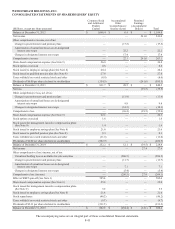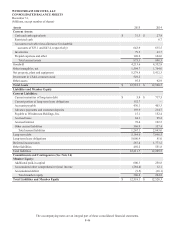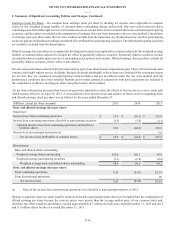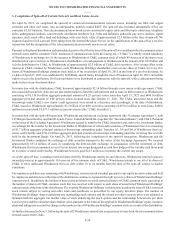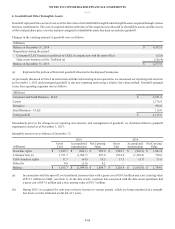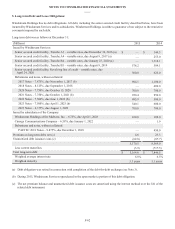Windstream 2015 Annual Report Download - page 182
Download and view the complete annual report
Please find page 182 of the 2015 Windstream annual report below. You can navigate through the pages in the report by either clicking on the pages listed below, or by using the keyword search tool below to find specific information within the annual report.
NOTES TO CONSOLIDATED FINANCIAL STATEMENTS
____
F-52
2. Summary of Significant Accounting Policies and Changes, Continued:
Asset Disposals – On December 18, 2015, Windstream Services completed the sale of a substantial portion of our data center
business to TierPoint LLC (“TierPoint”) for $574.2 million in cash, net of the $0.8 million working capital settlement, and recorded
a pretax gain of $326.1 million. Excluding the effects of the gain, pretax losses for the data center business were $(0.5) million,
$(17.6) million and $(19.1) million in 2015, 2014, and 2013, respectively. The sale of the data center business did not represent
a strategic shift in our business nor had a major effect on our consolidated results of operations, financial position or cash flows,
and accordingly, does not qualify for reporting as a discontinued operation. As part of the transaction, we established an ongoing
reciprocal strategic partnership with TierPoint, allowing both companies to sell their respective products and services to each
other’s prospective customers through referrals.
On December 5, 2013, we completed the sale of Pinnacle Software Company (“Pinnacle”), a software company acquired in
conjunction with the 2011 acquisition of PAETEC Holding Corp. (“PAETEC”) for $30.0 million in cash. The software business
has been reported as discontinued operations for the year ended December 31, 2013. See Note 17 for further discussion of
discontinued operations.
Goodwill and Other Intangible Assets – Goodwill represents the excess of cost over the fair value of net identifiable tangible and
intangible assets acquired through various business combinations. The cost of acquired entities at the date of the acquisition is
allocated to identifiable assets, and the excess of the total purchase price over the amounts assigned to identifiable assets has been
recorded as goodwill. In accordance with authoritative guidance, goodwill is to be assigned to a company’s reporting units and
tested for impairment at least annually using a consistent measurement date, which for us has been January 1st of each year.
Goodwill is tested at the reporting unit level. A reporting unit is an operating segment or one level below an operating segment,
referred to as a component. A component of an operating segment is a reporting unit for which discrete financial information is
available and our executive management team regularly reviews the operating results of that component. Additionally, components
of an operating segment can be combined as a single reporting unit if the components have similar economic characteristics. If
the fair value of the reporting unit exceeds its carrying value, goodwill is not impaired and no further testing is performed. If the
carrying value of the reporting unit exceeds its fair value, then a second step must be performed, and the implied fair value of the
reporting unit’s goodwill must be determined and compared to the carrying value of the reporting unit’s goodwill. If the carrying
value of a reporting unit’s goodwill exceeds its implied fair value, then an impairment loss equal to the difference will be recorded.
Prior to performing the two step evaluation, an entity has the option to perform a qualitative assessment to determine whether it
is more likely than not that the fair value of a reporting unit exceeds the carrying value. Under the qualitative assessment, if an
entity determines that it is more likely than not that a reporting unit’s fair value exceeds its carrying value, then the entity is not
required to complete the two step goodwill impairment evaluation.
As of January 1, 2015, we had three reporting units, excluding corporate level activities. In performing our annual goodwill
impairment assessment, we estimated the fair value of each of our three reporting units utilizing both an income approach and a
market approach. The income approach was based on the present value of projected cash flows and a terminal value, which
represented the expected normalized cash flows of the reporting unit beyond the cash flows from the discrete projection period
of five years. We discounted the estimated cash flows for each of the reporting units using a rate that represents a market participant’s
weighted average cost of capital commensurate with the reporting unit’s underlying business operations. The market approach
included the use of comparable multiples of publicly traded companies operating in businesses similar to ours. We also reconciled
the estimated fair value of our reporting units to our total invested capital. As of January 1, 2015, based on our assessment performed
with respect to our three reporting units as described above, we concluded that goodwill for all of our reporting units was not
impaired as of that date, and accordingly, no further analysis was required.
During the fourth quarter of 2015, in connection with the disposal of our data center business and the reorganization of our business
operations, we reassessed our reporting unit structure as of November 1, 2015 and determined that we had five reporting units,
consisting of our four reportable operating segments and the data center operations subsequently sold and excluding corporate
activities. We are required to reassign goodwill to reporting units each time we reorganize our internal reporting structure that
results in a change in the composition of our reporting units. Our reporting units are not separate legal entities with discrete balance
sheet information. As a result, assets and liabilities utilized in or relating to multiple reporting units have been allocated to the
reporting units using consistent and reasonable allocation methodologies. Immediately prior to the change in our reporting unit
structure and reassignment of goodwill, we determined that no goodwill impairment existed as of November 1, 2015. In conjunction
with our change in reporting units and the reallocation of goodwill, we have also elected to change on a go forward basis the date
of our annual goodwill impairment assessment from January 1st to November 1st, which we believe is preferable because it more
closely aligns with the timing of our internal strategic planning process. Following the sale of the data center business, we no
longer have a separate data center reporting unit for purposes of performing our annual goodwill impairment assessment.



